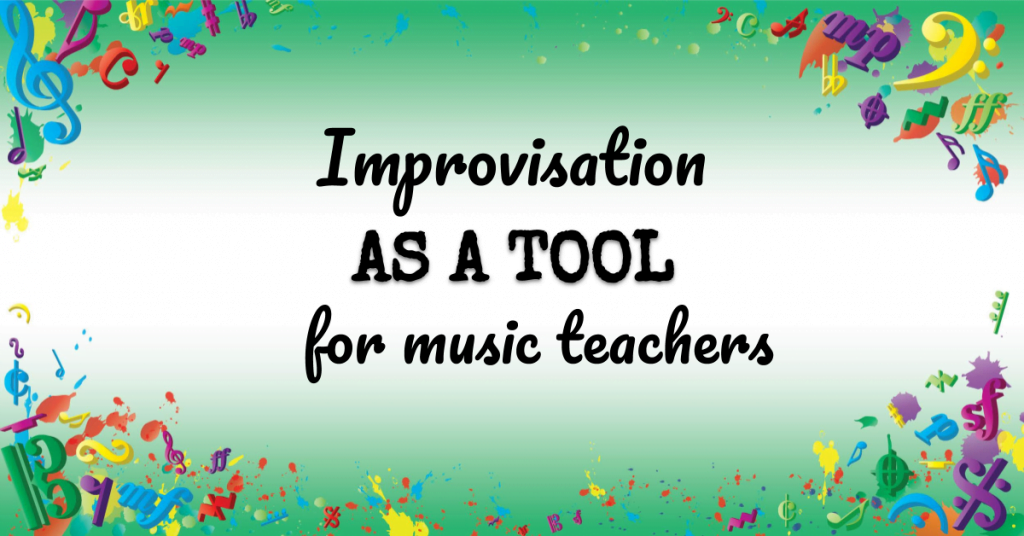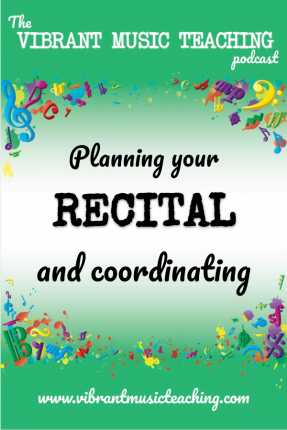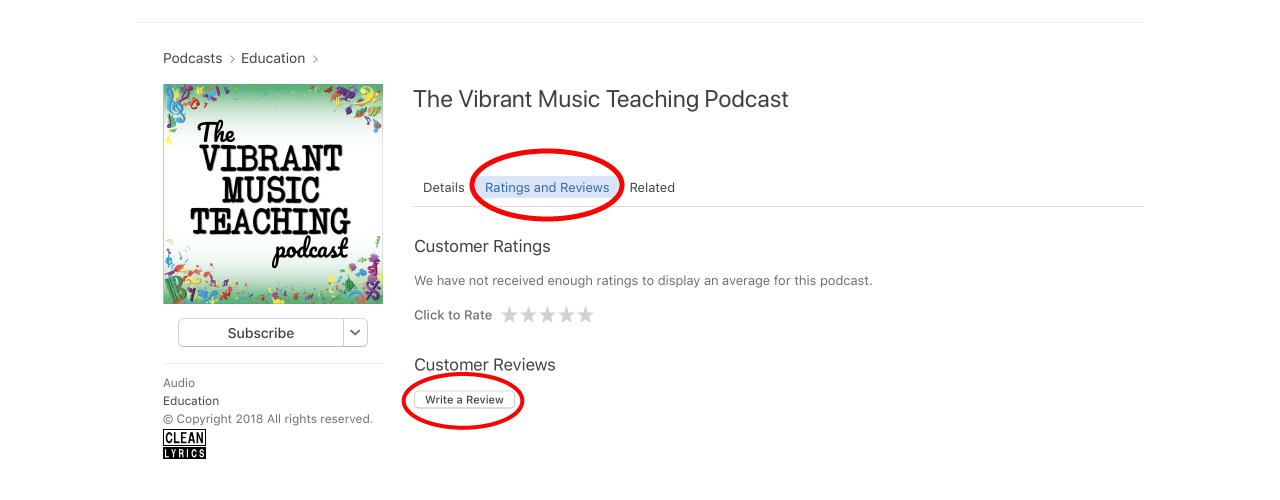Improvisation can be so much more than just another thing to fit into your packed lessons. In this episode, I’ll share with you how I use improvisation as a tool to teach other concepts and allow students to experience new things before labelling them.

Relevant Resources
FULL TRANSCRIPT
Click on any word to jump to that point in the audio. 🙂
VMT 35_Improvisation as a tool for music teachers.mp3 (transcribed by Sonix)
Vibrant vibrant vibrant music teaching proven and practical tips strategies than ideas for music teachers
You’re listening to episode 35 of the vibrant music teaching podcast. I’m Nicola Cantan and in this show we’re talking about what improvisation can do for your studio
Well hey there wonderful teachers. Welcome back to another episode of the vibrant music teaching podcast. I hope you’re enjoying the show. If you are please leave a rating and review on iTunes or wherever you’re listening today so that I know that you wanted to continue. And so that we can help other people find the show. Today we’re talking about improvisation. And I want to talk about it as a tool.
This may have been a little bit of a confusing title for you but it’s really how I’ve come to see improvisation and how I’ve come to use it in my studio as a tool for teaching other things not that it’s not important in its own right but just that this is how I made it do double purpose basically in my studio. First I want to share with you how I started with improv and this may be where you write you may be before this stage yourself so don’t worry if today’s episode is a little bit of a step too far. I’m actually going to share this perspective on improv with you today and then next week I will take you through beginner ways to get started. When I first started with improvisation it was something I had read about on various blogs and around the place and maybe seen videos of and had suddenly realized basically that it could be included in regular lessons that I didn’t have to be a jazz piano teacher that I didn’t have to be amazing at it myself in order to do these simple activities that I was seeing around the piano teaching blogosphere. So this is way back in the beginnings of the colorful keys blog before I’d even started blogging myself and I started trying some of these simple improvisation ideas. I plunged in. I took the leap. It was terrifying. But I started doing it anyway with some of my adult students initially and I saw it as something that I should fit into my lessons. I saw it as something that maybe had been not maybe definitely had been neglected for my own piano education for my own music lessons.
I was never really encouraged DoRe. You know even told that improvisation was a thing I could do. It was certainly never done in my lessons and it didn’t really occur to me that it should be part of what I do at the piano. Now maybe some people would naturally start doing that but I was. I’m a very I guess by the book person in some ways I follow direction and it never occurred to me to just noodle around or mess around because that wasn’t part of the prescription I was getting from my teachers. That’s a whole other conversation. But basically I wasn’t opened up to improvisation and I thought that it was something my students deserved to explore that they should have as part of their lessons. Maybe a small part but still a significant and important part. So that’s where I started from. From the perspective of this should be included in my lessons so I’m going to do it for my students sake. There’s nothing wrong with that. There’s a good reason to get going and if that’s where you’re at now and you haven’t started with it yet you’re thinking yet was left out of my my lessons and I wish it wasn’t and I don’t want to do a disservice to my students by leaving out of their lessons and great as I said next week I’m going to give you a starting point for getting going. But I do want you to listen even if you’re just starting out with improv to today’s episode because I think it’ll give you a different perspective on where you’re heading with improv or where you could be going.
So that’s the beginnings of improving in my piano teaching. It was all about something I should include and it was also something I thought was fun. It was a good break from other work. It was a good way to break the ice as well with new students or with students who were just getting too tense and I started doing that with some different patterns I learned online and then quickly found that pattern play books by Forest Kinney and started exploring those with my students as well and that was fantastic way to get started. And that’s really what I did for many years I tried to include some improv in at least every few lessons I wouldn’t even say every lesson at least every few weeks with almost all of my students and I started doing it definitely at the first lesson with every student as well. And that made a big difference in my teaching and that was wonderful. It was a whole new world to me gradually and in more recent years I started to see it a little bit differently. So this really came from the fact that I was thinking more and more about this idea of experience first teaching meaning that the old phrase which I’m going to misquote but it’s misquoted constantly I can’t even get to the origin of it. I believe it’s attributed to Confucius most commonly which is tell me and I forget show me and I learn involve me and I’m messing up the whole thing.
But you get the idea I know you know what I’m talking about here. So it’s about actually experiencing what we’re doing rather than being told what it is before and meeting in the case of music meeting the notation straight away before we move and experience what this feels like or what it sounds like. So I was thinking about this more and more and this is where my thinking on improvisation and how I use improvisation in my teaching started to evolve. I don’t see myself as an improv teacher. I’m certainly not a jazz teacher and if someone wants to be an amazing improviser that’s not something that they would come to me for or that they would stay with me for. I can get them started on the beginning but I would absolutely refer them to someone else if they want to be you know playing jazz or something in that style. What I see myself as being is someone who includes improvisation so that it’s not an unfamiliar world. And who uses it to teach certain things. And a lot of things actually. So improvisation was the perfect way to allow my students to explore and experience things before we put labels on them and showed them notation and talked about symbols and Italian terms and all of this improvisation became this natural way alongside games for my students to experience things first.
Okay so what can be taught in this way what am I talking about here. That’s really what can’t be everything can be almost everything can be improvised and experimented with before we put a label on it or before we slap you know a reading piece in front of our student for example steps versus skips Let’s go right to the beginning you can get your student to improvise using only steps and then improvise using only skips you could specify whether they can do melodic or harmonic or both and that way they can feel their way around the piano they can actually use steps and you skips before we say now is what they look like on the staff here’s how you can recognize them you’re recognizing a friend you’re not learning something by looking at the pattern on the page and then discovering what that means on the piano it’s the reverse so other opposites that work well would be things like high and low and loud and soft for beginners at getting them to explore those while you improvise along with them or improvising by themselves and creating sounds for different animals or for weather or for stories that you’re telling using improvisation and using their knowledge of where the different sounds live on the piano but it doesn’t have to be just for beginners you could also use this to teach different types of art relation to teach students how to phrase things to teach anything.
I love to use improvisation as a way to teach rhythm patterns and a way to carry rhythm patterns that we’ve been working on away from the piano over to the piano again before not just before meeting the notation but before having to concentrate on so many things at once. Like we do when we’re reading a piece I have lots of rhythm pattern exercises that I translate into improvisation in my course and my book which is called Rhythm in five I give suggestions on many of those for how to bring this into an improv activity so that you bring it to your instrument and connect the dots connect up things together again before putting a piece in front of a student where they have to read notes and concentrate on articulation and think about key signatures and all of this. I also use improvisation to teach scales as laid out in my circle appears to Odyssey course which is inside the vibrant music teaching side that course walks students through all 12 major keys and they explore the scales first through improvisation and this is my favorite way to teach scales these days is to get students to improvise with them first not using the correct fingering not first thing about country motion and similar motion and whatever other patterns we want to teach them. But first saying what is the pattern that they’re making on the piano. Why does it sound good and how can I you know play with chords underneath my student playing a scale with whatever fingers they feel like and actually experiencing how those patterns relate to each other how things fit together why a scale is a certain way what it means to be in a certain key signature.
I also use improvisation to teach chords. Again this is in a course in music teaching this called the chord crash course and this is also used a little bit in this circle of verse odyssey as well and in the piano power booster when we go into this too. So we’re exploring chords making improvising our own chord progressions and understanding how the different chords function which one saying Good. Which ones don’t and how they can create different moods. OK. So the challenge this week is to try it yourself. Try something by teaching it with improv first use improv as a tool to teach something this week. Pick out anything that you need to teach. Whether it’s one of the examples I just gave you there whether it’s something else that occurs to you that a student is going to encounter. This new concept in their book or in their upcoming piece think about a way that you could get them to improvise with that first and just see the difference it makes. Just try it out. Now as I said If you’re brand new to improvising this might be a step too far.
So next week I am going to share with you three easy ways to start improvising for the very first time in your piano lessons. Even if you’ve never done any improvisation before yourself OK. I’m going to give you three tips to get started. But if you already done a bit of improv I want you to take that challenge. Pick one thing that you can teach through improvisation. Try it out this week and let me know how it goes. You can get the show notes for today’s episode with the full transcript at vibrantmusicteaching.com/35 which is just the numbers 3 5. And I also have a webinar coming up that I want to let you know about all about improvisation and how you make it a regular part of your lessons not just something you do when you can fit it in not just something bad you do as a particular theme for a certain part of the year or something like that but how can you make it part of each and every lesson that you teach so that webinar you can sign up for it at vibrantmusicteaching.com/regular and of course the notes will be in the show notes for this episode. That’s it for this week. Guys go for a fourth improvise and have fun with it.
Music teaching members can now find a full piano power booster to cause inside the video library. This course is a follow on from piano player booster one and it will take you through the second year of lessons balancing aural work live and work theory games and technique with your piano students. Check it out in the library if you’re a member and if you’re not a member you can sign up at VMT.ninja.
Sonix is the best online audio transcription software in 2019.
The above audio transcript of “VMT 35_Improvisation as a tool for music teachers.mp3” was transcribed by the best audio transcription service called Sonix. If you have to convert audio to text in 2019, then you should try Sonix. Transcribing audio files is painful. Sonix makes it fast, easy, and affordable. I love using Sonix to transcribe my audio files.

Subscribe and Review the Vibrant Music Teaching Podcast
Subscribe to the podcast in Apple Podcasts or iTunes here so you don’t miss the next episode and you can take it with you as you run errands, clean the house or walk the dog.
If you’re enjoying the podcast please take a moment to leave a review and a rating.
- Click here to open the podcast page
- Click “view in iTunes” if it doesn’t automatically open there
- Click “Ratings and Reviews” and leave a review

What did you think of this episode?
Let me know in the Vibrant Music Studio Teachers group on Facebook. I’ll see you there. 🙂